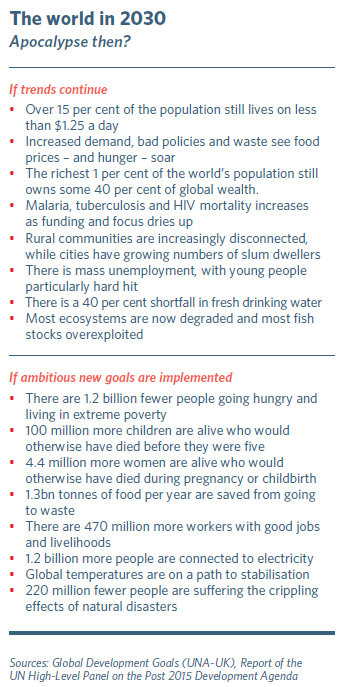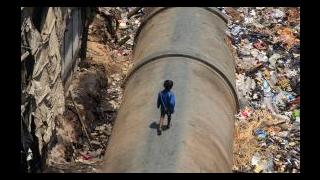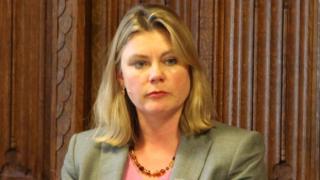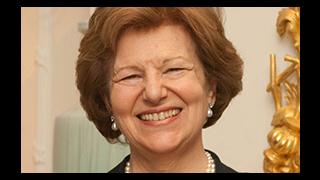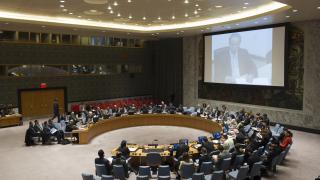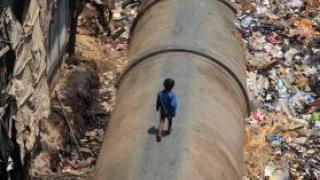
On 25 September, at the UN Special Event on the Millennium Development Goals and post-2015 development agenda, world leaders endorsed the creation of a single framework and set of goals on poverty eradication and sustainable development. They also reaffirmed their commitment to accelerating progress towards achieving the existing goals by their 2015 deadline.
This briefing provides an update on MDG progress to date, the context in which the new development agenda is being created, and recommendations on the road ahead.
In 2000, Kofi Annan, then-UN Secretary-General, addressed world leaders at the Millennium Summit with the following words: “in an age when human beings have learned the code of human life and can transmit their knowledge in seconds from one continent to another, no mother in the world can understand why her child should be left to die of malnutrition or preventable disease.” The Summit saw the adoption of the Millennium Declaration, a set of progressive proposals for the new century.
The Millennium Development Goals (MDGs) are eight time-bound goals, with targets and measures, each of which aims to significantly ameliorate development challenges by 2015. They have been hailed as the most ambitious and focused development effort by the international community, providing a coherent blueprint for all countries agreed through a series of UN summits.
Progress to date
At the global level, several of the MDG targets have already been met or are within close reach. But accelerated progress is needed in many areas.
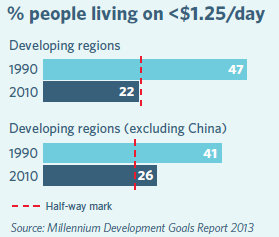 The world reached its target of halving the proportion of people living in extreme poverty five years ahead of schedule. Around 700 million fewer people lived on less than $1.25 a day in 2010 than in 1990, with every developing region making progress. However, much of this progress can be attributed to a clutch of emerging economies, most notably China. Globally, 1.2 billion people still live in extreme poverty. Even more survive just above that level, with 60 per cent of workers in the developing world making under $4 a day.
The world reached its target of halving the proportion of people living in extreme poverty five years ahead of schedule. Around 700 million fewer people lived on less than $1.25 a day in 2010 than in 1990, with every developing region making progress. However, much of this progress can be attributed to a clutch of emerging economies, most notably China. Globally, 1.2 billion people still live in extreme poverty. Even more survive just above that level, with 60 per cent of workers in the developing world making under $4 a day.
The target to halve the proportion of those suffering from hunger is within reach, as this has fallen from 23.2 per cent in 1990–1992 to 14.9 per cent in 2010–2012. But progress has slowed, in part due to the economic crisis. One in eight people – some 870 million – remains chronically under-nourished. At nearly one-third, the percentage of severely underweight children aged five and below is highest in southern Asia.
Although the number of children not receiving primary education declined by almost half over the past decade, from 102 million in 2000 to 57 million in 2011, the goal of universal primary education will be missed if current trends continue. Poor, female and rural children continue to fare less well than their counterparts.
Gender parity is closest to being achieved at the primary level but just two out of 130 countries included in the MDGs have achieved this target at all levels of education. Advances in gender empowerment outside primary school – in employment, social protection and decision-making – have been far less encouraging.
While big gains have been made in child survival, with deaths per 1,000 live births dropping from 87 in 1990 to 51 in 2011, the reduction target of two-thirds is still some way off. In sub-Saharan Africa, the worstaffected region, one in nine children dies before their fifth birthday. A growing proportion of these deaths occur at or around the time of birth – a trend present in all developing regions.
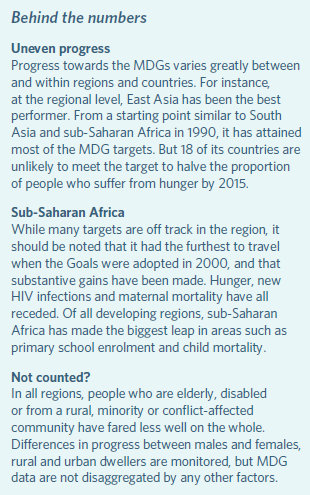 Like child mortality, maternal mortality is overwhelmingly the result of preventable causes. Although the ratio of deaths per 100,000 live births has declined by nearly half worldwide, the 75 per cent target looks out of reach. The picture is similar for family planning. Access and use has increased in all regions, but some 140 million women still have an unmet need.
Like child mortality, maternal mortality is overwhelmingly the result of preventable causes. Although the ratio of deaths per 100,000 live births has declined by nearly half worldwide, the 75 per cent target looks out of reach. The picture is similar for family planning. Access and use has increased in all regions, but some 140 million women still have an unmet need.
Mortality rates from measles, tuberculosis and malaria have fallen markedly, with tens of millions of lives saved during the first decade of the new millennium. New HIV infections are declining but 2.5 million people still contract the disease each year. More of them are receiving antiretroviral therapy than ever before. The target of universal access was missed in 2010 but remains in sight for 2015. As with all health targets, impressive gains could be reversed if momentum is not maintained.
Nearly two billion people gained access to adequate sanitation over the past two decades. But another billion must be reached for the sanitation goal to be achieved. During the same period, 2.1 billion people gained access to improved sources of drinking water. That MDG target has been met well ahead of schedule.
So too has the target to improve the living conditions of 100 million slum dwellers. Twice that number now have better housing, sanitation and water. However, the absolute number of people in slums has risen.
Modest progress has been made on increasing the coverage of protected land and marine areas. Yet environmental sustainability continues to be under severe threat around the world. After a small blip during the 2008–2009 financial crisis, carbon emissions are back on the rise – up 46 per cent on 1990 levels. Forests are disappearing at an alarming rate and fish stocks are now below the level at which they can produce sustainable yields. Bird and animal species are moving towards extinction at an ever-faster pace.
Official development assistance (ODA) fell for the second consecutive year in 2012. Only five donors have met (and exceeded) the long-standing target of giving 0.7 per cent of GNI in aid: Denmark, Luxembourg, the Netherlands, Norway and Sweden. (The UK has pledged to reach this target in 2013–14.) There have been some improvements in trade, with duty-free access to rich countries increasing and tariffs and debt service ratios declining. But a balanced, development-oriented conclusion of the World Trade Organization’s Doha Round of negotiations remains elusive. And least-developed countries in particular lack access to technology and medicine.
A success story?
The first decade of the MDGs has seen significant improvements in the lives of millions of people around the world. It is not easy to measure definitively the Goals’ impact, as other factors, such as economic growth have contributed to their achievement. What is clear is that the MDGs have generated an unprecedented degree of consensus on development priorities, above all poverty reduction.
But a number of shortcomings are evident. The focus on aggregate targets has masked inequalities between and within states, especially in relation to vulnerable groups. In certain countries, goals have been met nationally with little change for the poorest, raising concerns that the framework has incentivised decisionmakers and donors to pursue the easiest gains, instead of focusing on those hardest to reach.
The Goals have been described as prioritising quantity over quality, and omitting important development challenges such as tackling non-communicable diseases, which kill more people than HIV/AIDS, malaria and tuberculosis. They have also been criticised for being too modest – aiming to improve conditions for just a small proportion of slum dwellers for example – and rooted in existing development trends, and for reflecting a topdown, North-to-South paradigm that marginalises local participation.
The road to 2015 and beyond
In May 2013, the UN High-Level Panel on the Post- 2015 Development Agenda released its much-anticipated report, which set out a framework for 2015–2030 aimed at eradicating poverty and remedying these shortcomings. It identified five transformational shifts – addressing inequalities, sustainable production and consumption, job creation and inclusive growth, peaceful and open societies and “a new spirit of solidarity, co-operation and mutual accountability”. As part of this framework, the report proposed 12 illustrative goals. It also called for disaggregated data to be used when assessing progress and for targets to be considered achieved only if they are met for all relevant income and social groups.
At the UN Special Event in September 2013, world leaders resolved to accelerate progress on the Goals, calling for increased efforts on gender empowerment, reaching the 0.7 per cent GNI aid target and strengthening partnerships. They also agreed to create a new single set of goals for poverty reduction and sustainable development, meaning the processes for creating the post-2015 agenda and the sustainable development goals (agreed at the Rio+20 Summit in 2012) will have to come together before 2015. This new development framework is to be universal in nature and applicable to all countries, with targets on peace and security, democratic governance, the rule of law, gender equality and human rights. Intergovernmental negotiations are to begin at the UN next September.
UNA-UK has called for this process to include a strong focus on how the new framework will be financed, what institutional reforms will be needed, what opportunities there will be for ongoing public participation, and how the framework will relate to discussions on a global climate agreement, also scheduled for 2015.
Illustrative goals and targets
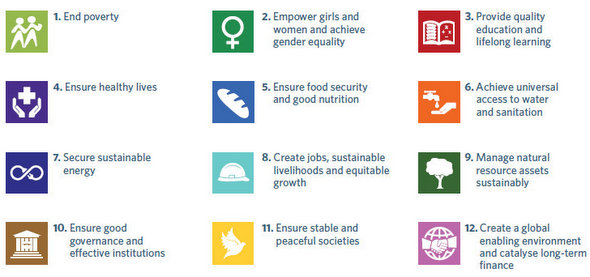
Source: Report of the UN High-Level Panel on the Post-2015 Development Agenda
UNA-UK recommendations
UNA-UK will continue to report on developments in the lead-up to 2015. To inform global discussions, the Association has produced a major publication entitled Global development goals: Leaving no one behind. With contributions from over 50 experts and practitioners, the publication analyses progress, gaps and lessons learned for each goal, as well as for cross-cutting themes such as the role of business and particular needs of landlocked developing countries. It also provides recommendations for the new framework, including:
- Retaining the simplicity and focus of the MDGs, within the broader context of security, development, human rights and good governance
- Recognising the need for economic growth to occur within planetary boundaries
- Ensuring the goals have enough flexibility to be adjusted to national and local realities and needs, and creating inclusive processes for making such adjustments
- Investing in public services and infrastructure to support development gains and empower local and national governments
- Emphasising decent work, knowledge- and skillsbased education, and social protection
- Strengthening existing and forging new partnerships for financing, delivering, monitoring and evaluating the new development agenda
- Supporting better data collection and analysis
- Developing methods for local initiatives to be shared, scaled-up and replicated, both between and within countries
- Developing proposals to extend the reach of existing technological innovations and support new ones.
Fostering a global outlook
Underlying all of these recommendations is the need to foster a global outlook in decision-making at the local and national levels. The post-2015 framework is being developed in a very different environment to the MDGs. The period since 2000 has seen a shift in the global economic balance. The financial crisis has hit developed and developing countries. A large proportion of the world’s extremely poor people now live in middle-income countries. The impact on poverty of conflict, poor governance, inequality, climate change and environmental degradation are more widely understood and accepted.
According to the International Monetary Fund, foreign direct investment, remittances and portfolio equity flows have all overtaken ODA. While aid remains a life-saving tool, responsible business, immigration and investment policies are equally important.
For governments, it has been a difficult period, characterised by the need to respond to immediate challenges as well as the increasing urgency of tackling long-term ones. At the Millennium Summit in 2000 and the World Summit in 2005, world leaders agreed sweeping international agendas and reform programmes. This task will be much harder in 2015 unless governments and publics recognise that an ambitious, achievable development framework is in everyone’s interest.

